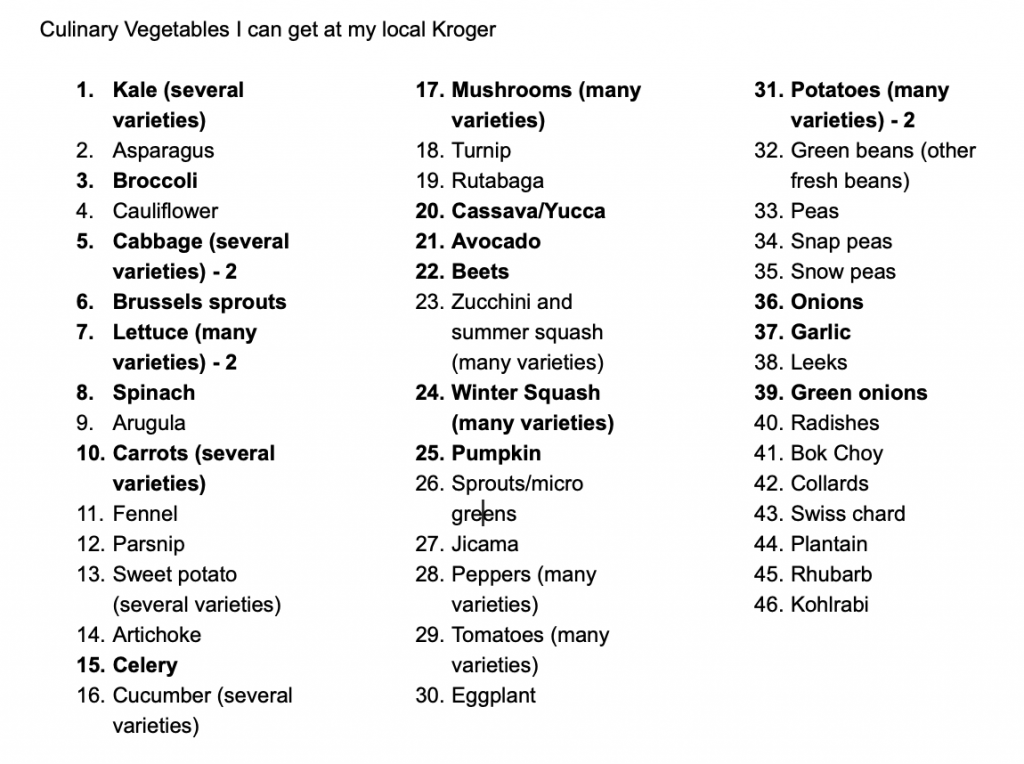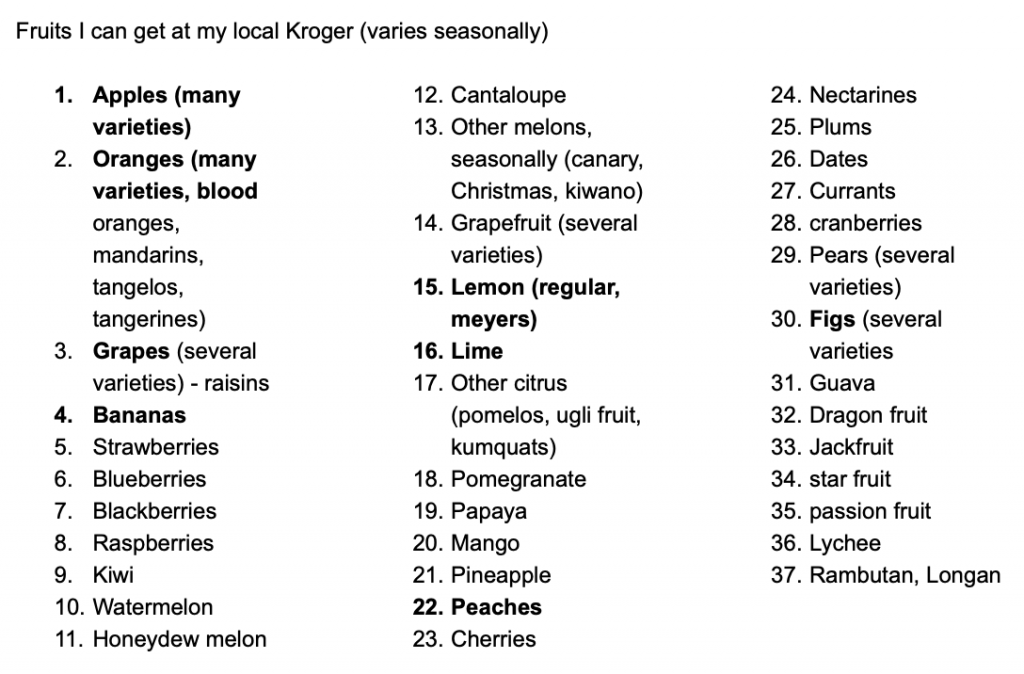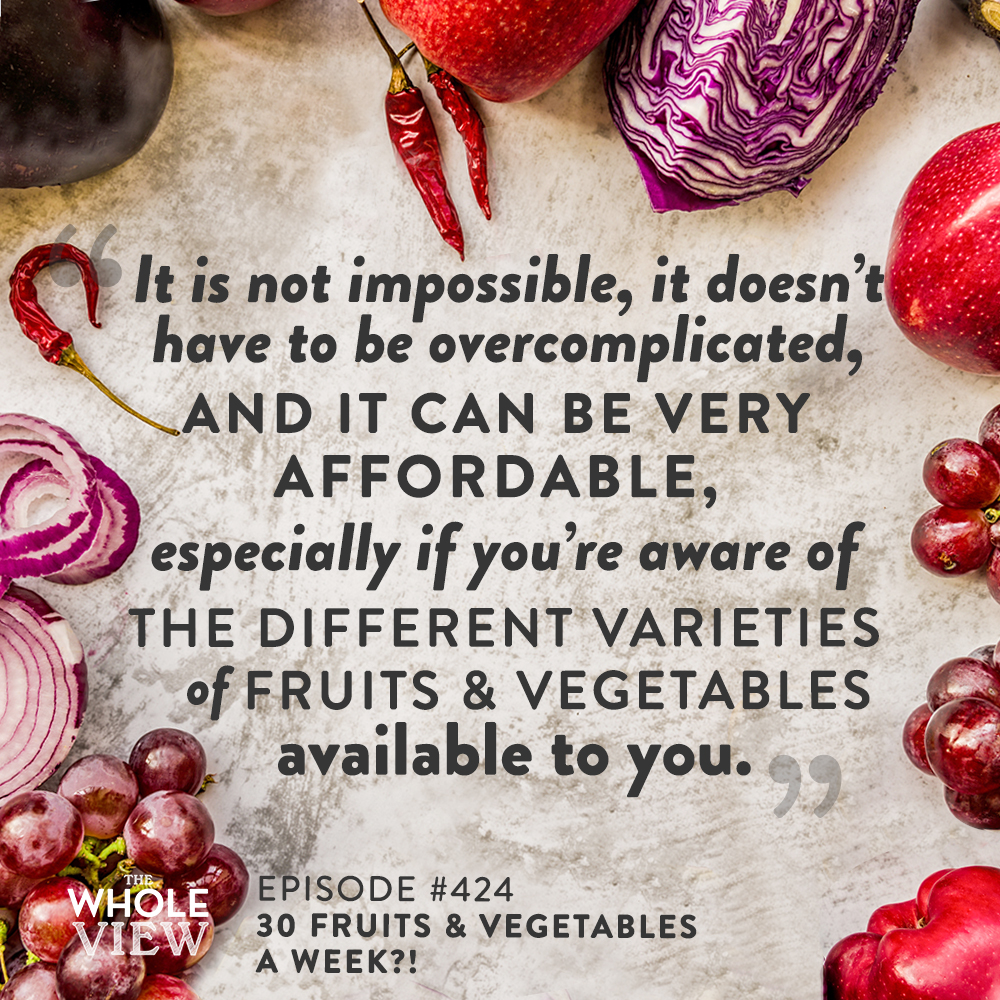
Welcome to episode 424 of The Whole View! This week, Stacy and Sarah break down the 30 fruits and vegetables a week recommendation, where it comes from, and why it’s not as scary as it sounds. You’ll also get a look into just how many fruit and vegetable varieties are available at your local grocery store. Sarah and Stacy also provide plenty of helpful tips and tricks, from recipes to shopping on a budget, all to help you reach that 30-a-week goal!
If you enjoy the show, please review it on iTunes!
The Whole View, Episode 424: The Scientific Method
Welcome back to episode 424 of the Whole View. (0:27)
Sarah feels it’s important for the audience to know this show is not about guilt. It’s about empowering and inspirating!
Sarah has posted in the past that, as a general rule, we should all aim to eat at least 30 different vegetables and fruits throughout the week.
For Stacy, that number was a little mind-blowing. She hopes that by breaking that number down, she can see how far off she really is from reach 30.
She also hopes this helps listeners understand what Sarah meant by that expectation.
This is a topic Sarah has seen many discussions (and panic) about because 30 sounds like a lofty goal.
In this episode, she’ll explain where that recommendation comes from and the science behind it.
Sarah believes most people are closer to eating 30 different fruits and vegetables per week than they realize. And she hopes she can help reassure listeners who may find that number overwhelming.
We would like to remind our audience that it’s important not to let perfection be the enemy of the good.
This is not about checking boxes, but about setting a fuzzy goal aimed at increasing variety.
Sarah shares several comments from the original post that stuck out to her.
She hopes that by going deeper into this topic, listeners will realize that it’s not as scary as a number as it seems.
Where The Recommendation Comes From
Sarah shares some relevant findings from her six-year study of the gut microbiome. (4:47)
Different families of fruits and vegetables are independently beneficial because they feed different subsets of bacteria.
Sarah explains that diversity between the types of bacteria and microbes is the hallmark of a healthy gut. She then explains their interactions affect the human body.
How we achieve diversity is through ensuring there’s variety in types of fruits and vegetables we eat. And not that we’re picking the same ones over and over.
Sarah recommends the American Gut Project for further research data on the gut microbiome.
The way we practically achieve diversity in our gut microbiome is through food diversity, and that’s because different types of foods feed different species of bacteria.
Sarah’s research shows fruits and vegetables are the best for the gut microbiome.
Nuts and seeds are also fantastic.
But only some legumes and grains are, and they shouldn’t replace servings of fruits or vegetables.
Stacy does the math for what she’s eaten, not even going back a full week. She shares she’s already reached 26 (not including nuts, seeds, or herbs).
She jokes that she’s not the type to snack on raw vegetables either!
Does My Store Really Have That Much?
Breaking meals down by ingredient can show how many vegetables we use on a daily basis without us even realizing it. (14:37)
Sarah shares that in her fruit bowl alone, she has 10 different kinds of fruit.
The average grocery store has roughly 200 different fresh fruits and vegetables year-round when counting different varieties separately.
Sarah reminds us that this is a rough guideline and not a list of check-marked boxes.
The goal is to think about variety and swap out different types of foods week-to-week.
Stacy lists kale, carrots, spinach, cabbage, lettuce, squash, tomatoes, potatoes, and mushrooms.
Stacy recommends researching recipes that utilize different types of add-ins to increase variety.
Muffins, oatmeal, and smoothies can all include multiple fruits or vegetables.
Some fruits and vegetables are seasonal, but many are in season year-round.
Stacy explains that seeking out opportunities to add different ingredients is how she could reach so many varieties easily.
Sprouts are a great way to add a micronutrient punch to meals. And Stacy was surprised to find how much her kids liked them as well.
Sprouts are also fun and easy to grow at home!
Stacy reminds us that the more we look at what we’re eating daily, the more we realize how easy reaching 30 varieties really is.
Stacy talks about different nightshades, like tomatoes, peppers, and eggplants. She also tells us potatoes are a great root vegetable use and can be combined with other ingredients to enhance variety.
Onions and garlic are great “freebies” that count toward reaching that weekly goal.
Stacy recommends trying roasted radishes for anyone who isn’t a radish fan.
Rhubarb and kohlrabi may be a little harder to find, but they are great seasonal vegetables to add to your diet to achieve variety.
Stacy reminds us that frozen is perfectly acceptable. This is because when things are frozen, they’re picked at peak ripeness, and their nutrients are maintained.
Sarah explains that it’s okay to have a core 5 or 10 foods that you buy every week, just be sure to keep a variety outside of it.
Below is the complete list of vegetables Stacy and Sarah talk about in the episode:

What About My Store’s Fruit Variety?
Fruit availably often vary depending on the time of year, but many stores will offer different varieties throughout each season. (43:42)
Sarah would like to emphasize finding a feeling of excitement when something unusual comes into your store.
Don’t be afraid to move out of your comfort zone (at your own pace) to try new things.
It’s never too late to start becoming more adventurous and widening our varieties.
Stacy points out that there are a lot of opportunities to find foods you like. She shares that she does like prunes (dried plums) and dates despite not particularly liking plums.
Stacy lists blackberries, blueberries, strawberries, and raspberries as fruits she often freezes.
Many types of melons and citrus fruits are available throughout the year. Varieties often rotate based on seasonality as well.
Stacy suggests reaching out to your local garden center if you’re interested in growing your own fruit.
Both Sarah and Stacy share stories about plants they’ve grown (both successfully and unsuccessfully) at home.
Stacy promises not all plants are high maintenance or difficult to grow. She assures us that we are capable of growing them if we would like to.
Sarah also wants listeners to know that many vegetables will grow in containers. So even if you don’t have space for a fruit tree, you can still increase your food variety with a small porch or balcony.
Stacy challenges listeners to check out the “exotic fruit” section of their stores and to have some fun and choose something new to try.
Guava, dragon fruit, jackfruit, star fruit, passion fruit, lychee, and rambutan are a few of the fruits found in the exotic section.
Together, Sarah and Stacy named 46 different vegetables and 37 different fruits in this one episode alone.
Stacy shares that her final count is now up to 29 different fruits and vegetables in just 5 days!
Stacy’s final verdict? Reaching the recommended 30 was not as scary as she originally thought.
Below is the complete list of fruits Stacy and Sarah talk about in this episode:

Storing and Meal Planning
Sarah tells us that it’s surprising how much is available in terms of seasonality and locality. (1:02:40)
She suggests referring to a seasonal produce guide as an easy reference.
Sarah feels storage is important to talk about and that most fruits and vegetables keep for about a week if stored correctly.
Her Gut Health Cookbook also has an entire section on storing vegetables and fruits and is now available.
This free guide from UCDavis is also a great reference for knowing what does and doesn’t store well together.
Sarah reminds us that there are many ways to get inventive when storing fruits and vegetables. And not to let lack of space stop us from achieving a great variety.
Soups, stews, stir-fry, salads, smoothies, and frittatas are great recipes that allow you to throw in different vegetables.
Stacy shares one of her favorite tricks with soups is to roast the vegetables first. Then blend them into the soup or stew to get a gravy-like texture.
If you’re listening to this episode in the fall, Stacy states now is a great time to play around with different soups and stews.
Stacy recommends meal planning by going through different cookbooks and not to be afraid to have fun with it.
She is also a big fan of Pinterest for finding new recipes. She will pin a bunch of ideas and then go through them with her kids to find things they want to try.
Finding Affordable Fruits and Vegetables
It is not impossible, it doesn’t have to be overcomplicated, and it can be very affordable, especially if you’re aware of the different varieties of fruits and vegetables available to you.(1:09:38)
Onions, lettuces, cabbage, root vegetables, and spinach are all very affordable and available.
Apples, bananas (Stacy recommends Fairtrade), and oranges are often pretty inexpensive fruits.
In-season fruits and vegetables are generally cheaper, so knowing what’s in season can help you shop on a budget.
Sarah makes us aware that eating more vegetables, in general, is a budget-strategy for a grocery bill.
She goes on to say that this is an area that she thinks the Paleo-diet did her a disservice.
She went through a phase early on where she was eating very large portions of meat and getting more protein than she needed.
Meat tends to be a more expensive item on the grocery list, while vegetables tend to be some of the least.
Stacy feels that it’s important to make listeners aware that if you or someone you know is part of the WIC Program, some WIC-eligible fresh fruits and vegetables are required by the state.
That includes organic forms of those products (whole or cut).
Sarah urges us to keep in mind that even though grains, wheat, and rice products seem much cheaper, by comparison, there are a lot of budget-friendly fruits and vegetables available as well.
Final Thoughts
Sarah hopes that most of today’s listeners realized they, like Stacy, were much closer to reaching 30 than they thought. (1:16:34)
If you’re someone who might be farther away from reaching 30, Sarah wants you to know that that’s okay. And there are many things you can do to help you increase that variety.
It’s okay to baby-step the process.
Sarah doesn’t want anyone to feel like they have to readjust their lives to meet the recommendation.
Finally, Sarah would like to encourage our listeners to think about this in a positive mindset. You can do it! And it’s okay to iterate towards it.
30 is not a hard-and-fast number; it is a goal. It’s there to provide some guidance into what high-variety is.
Stacy reminds everyone that a goal isn’t something that’s meant to be achieved every single week.
Goals are meant to push us to strive for something better. And just because we don’t make it every single time doesn’t mean we are failing.
Stacy adds that she hopes this episode leaves you feeling empowered and excited.
If you enjoyed this show, the best thing you can do is share it with others.
If this was helpful to you or cleared your conscience, please let us know. We love to hear from you!
If you’re still feeling overwhelmed and would like more information, that feedback is very helpful and keeps us going. (1:24:24)





